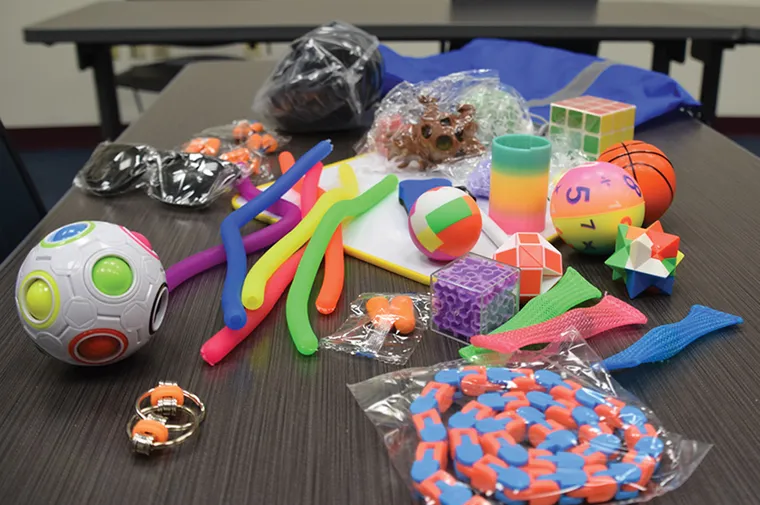Sensory bags bridge communication gap between officers and community
By Marika Carley
On an overcast, late April day, a young boy runs along Georgia Avenue—a busy thoroughfare in Montgomery County, Md.,—barely avoiding being hit by passing vehicles. The child is spotted by Sgt. Trevin Sherard, a Montgomery Parks Police officer, who happens to be driving past the scene. Sherard immediately springs into action to help the child. After interacting with the boy, the officer recognizes that the child is nonverbal and likely autistic, so he brings out his sensory bag.
A Collaborative Effort With An Immediate Impact
In April 2022, The Maryland-National Capital Park Police (M-NCPP), Montgomery Parks Division, and the Montgomery Parks’ Program Access Office collaborated to equip officers with sensory bags, which allow officers to bridge the communication gap between themselves and individuals from vulnerable populations with different cognitive abilities and neurodiversity and who may be verbal or non-verbal, distressed, or overstimulated. In August 2021, the bags were distributed to the Search & Rescue team and K-9 units for use by first responders. Sensory tools have been utilized across different settings to stimulate the senses, calm an individual, or allow a person to concentrate. During a crisis, a person may not understand everything that is happening, especially when a first responder arrives on the scene. Filled with fear, curiosity, or heightened anxiety, some individuals may not be able to respond appropriately to directions or understand that someone is there to help them.
“The idea for the bags was actually a collaboration between me and (park police officers) Lt. Frank Wulff and Cpl. Herman Hodges,” explains Genevieve Jennai, who in 2021 was Program Access Specialist at Montgomery Parks. “I’d worked with Officer Hodges previously, and he wanted to do outreach; Lt. Wulff, who was Search & Rescue, was also interested.”
“A couple of days after getting the bag, a Search & Rescue member used it at a funeral he attended,” says Jennai, now the therapeutic recreation coordinator of northern programs at Prince George’s County Department of Parks and Recreation, Montgomery Parks’ sister agency, both part of the Maryland-National Capital Parks and Planning Commission (M-NCPPC). “That was a sign the initiative was going to be a success.”
According to Wulff, the bags are used an average of once or twice a month, and the impact is immediate. “Our officers have always been trained in understanding that situations may require thinking outside the box, and usually utilized small toys, stickers, and such, but now that they have been issued the sensory bags, they have a much better tool to handle these interactions,” he says.
A Useful Tool
When creating the bags and deciding on the contents, Jennai says that many factors had to be taken into consideration. “There has to be a variety of items in there,” she explains. “We needed to have different textures because some people are sensitive. The items needed to be reusable and washable and not personalized. Some people have light or noise sensitivity, so sunglasses and earplugs are important. The bags must have at least one thing that is pleasing to that sensory fulfillment.”
The bags’ contents include whiteboards, noise-blocking headphones, puzzle balls, Slinky toys, finger traps, sensory bean pods, Rubik’s Cubes, stress balls, pop’em balls, and Tangles. The 25 bags cost $1,000 to assemble.
In the year they have been in use by park police, the bags have assisted in several situations, even only two hours after they were distributed to officers. “We had an incident where a young child went missing and was also hard of hearing, and our officers identified this and realized it was a chaotic situation and actually utilized of all things, a Slinky, to calm down the situation,” Wulff told a local news station.
Park police have used the bags after finding missing children and teens, during criminal investigations into abuse, and on funeral details, among other uses. “The population has mostly been children and teens with autism, but these bags aren’t limited to people with autism. They can be used for any children that may be experiencing a traumatic incident, such as a car accident or a victim of crime,” says Wulff. The bags can also be used with adults.
A Commitment To Inclusion
The goal of Montgomery Parks’ Office of Program Access is to ensure individuals are “afforded respect and dignity while engaging in leisure pursuits to enhance their quality of life in a clean, safe, and accessible setting.”
As chief of police, M-NCPP, Montgomery County Division, Darryl McSwain says when the bags are first distributed to officers, “Our goal is to always foster positive interactions with all patrons of our park system. To ensure our efforts are productive, it is important that we continue to educate ourselves on best practices from various disciplines for maximum effectiveness. Our motto is ‘Stronger Together’; this partnership exemplifies that.”
Montgomery Parks is committed to providing sensory-friendly spaces across the department. Similar bags are available at Montgomery Parks’ facilities and are used by support staff to help patrons who may become overstimulated in a camp or activity. Additionally, the department has initiated sensory-retreat tents or areas at larger special events to provide an escape for people who may be overwhelmed by sound and sensory overload. The four-sided tents contain bean bags and rocking chairs, fidgets, headphones, bubble machines, fans, and other items. “The tents are well used by families of children with autism,” says Jennene Blakely, Montgomery Parks’ program access manager. “But we also see moms whose children are having a difficult time and adults who need a break from the sun.” Blakely also stresses the importance of inclusion in the parks. “We’re providing a safe and inclusive space where families know their child can participate in a program or event as individuals with autism or other disability without judgment or stigma.”
A Happy Ending
Sherard’s sensory bag immediately impacted the behavior of the 9-year-old boy he found running in the street. Wulff and another officer responded to assist. With the further help of a Samaritan, officers were able to search for a red car, which the child kept mentioning, and they were able to locate a residence with an open fence. Upon seeing the house, the child recognized his home, ran into the house, and was reunited with his parents. “Sgt. Sherard’s quick actions quite possibly saved this young child’s life that evening,” says Wulff. “These bags are a great tool, and this incident just proved even more how valuable they are!”
Wulff and Jennai still speak often, and he always informs her of sensory bag success stories. “It’s good to know that they’re having such a good effect in the community. It’s an amazing program, and I hope it trickles down to all police departments,” says Jennai. “It’s truly a ‘winning sense-sation’ to work as a team to help the community.”
Marika Carley is the Public Relations and Outreach Specialist for Montgomery Parks in Maryland. Reach her at marika.carley@montgomeryparks.org.

